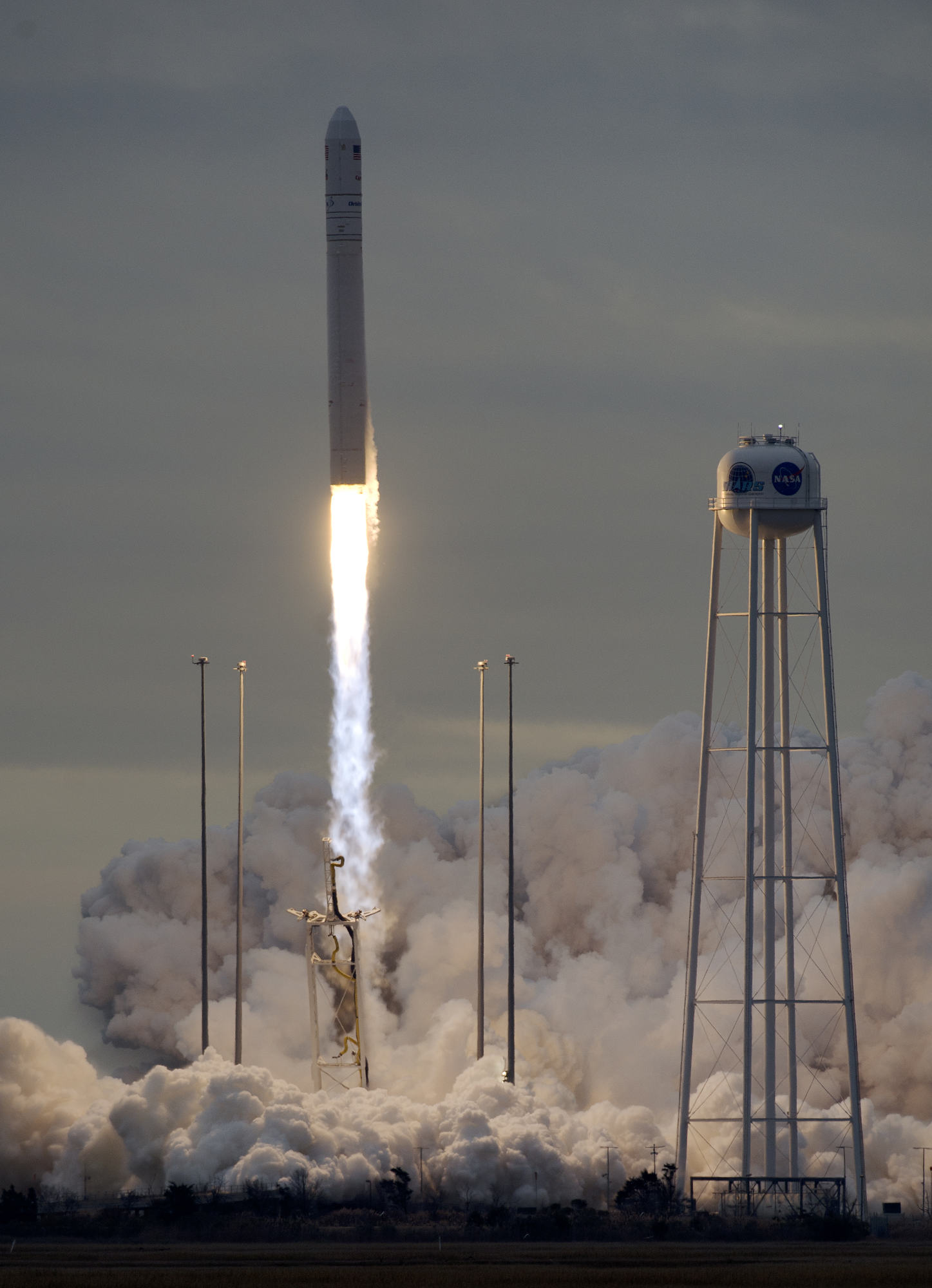

Much of the Atlantic shoreline of Wallops island has been lined with a stone seawall to protect launch infrastructure from ongoing erosion and shoreline retreat. Wallops’ P-3 Orion, for instance, is the key aircraft supporting Operation IceBridge, a multi-year survey of polar ice. To the north, the main campus of NASA’s Wallops Flight Facility serves as home base for a range of aircraft used to conduct earth science research. On the mainland, the Wallops Geophysical Laboratory appears as a line of four white dots. A causeway and bridge connect the island with the Delmarva peninsula. A variety of launch-related infrastructure is visible along the coast, including rocket storage and assembly buildings, launch pads, and protective sea walls. The Operational Land Imager (OLI) on Landsat 8 captured this image of Wallops Island and the surrounding area on May 3, 2014.

Both the Antares and Cygnus were built by Orbital Sciences Corporation, a Virginia-based aerospace company. The Antares will carry an unmanned Cygnus spacecraft loaded with 3,293 pounds (1,493 kilograms) of supplies to the International Space Station. Weather permitting, the Antares or its contrail will be visible in Washington, DC, after 90 seconds in Philadelphia after 120 seconds in New York City after 150 seconds and in Boston after 210 seconds. At that time, a thirteen-story Antares rocket is scheduled to lift off from launch pad 0A. Residents from South Carolina to Massachusetts should have an opportunity to see one of these larger rockets if they look toward the island starting at 12:52 p.m. While most involved modestly-sized meteorological and sounding rockets, the completion of launch pad 0A at the Mid-Atlantic Regional Spaceport (MARS) in 2011 has made it possible to launch larger and more powerful rockets. Since then, more than 14,000 rockets have lifted off.

On July 4, 1945, NASA’s predecessor-the National Advisory Committee for Aeronautics (NACA)-launched the first rocket from Wallops, making the island one of the oldest launch sites in the world. Today, the island is the site of a thriving spaceport that launches several commercial and government rockets each year. You can register to attend this launch virtually.More than seventy year ago, wild ponies roamed the marshes and beaches of Wallops Island, a barrier island on Virginia’s Eastern Shore. If you can’t stomach standing out in the cold to watch, there are numerous ways to see the launch from afar. The NASA Visitor Center at Wallops Island will not be open for the launch. The Virginia, Maryland and Delaware Atlantic beaches also provide good viewing locations. If the sky is clear, launch fans will be able to watch from Robert Reed Park on Main Street or Beach Road spanning the area between Chincoteague and Assateague Islands.
WALLOPS ISLAND LAUNCH VIEWING SKIN
Among the fascinating research that will be conducted with the materials carried by Antares is an investigation on skin aging in microgravity that may help protect aging skins, testing on a lithium-ion secondary battery that works under extreme temperatures in a vacuum, and a study looking at a drug’s impact on prostate and breast cancer cells.Īntares will launch from the Mid-Atlantic Regional Spaceport’s Pad 0A on Wallops Island. This one, Northrop Grumman’s 17th mission to deliver NASA science investigations, supplies, and equipment. In the meantime, Northrop Grumman’s Antares rocket will continue to make commercial resupply missions. By passing the mission to private platforms, NASA believes it will save $1.3 billion. ISS will be replaced by three free-flying space stations developed by commercial companies Blue Origin, Nanoracks LLC, and Northrop Grumman, based in Dulles, Virginia.


 0 kommentar(er)
0 kommentar(er)
